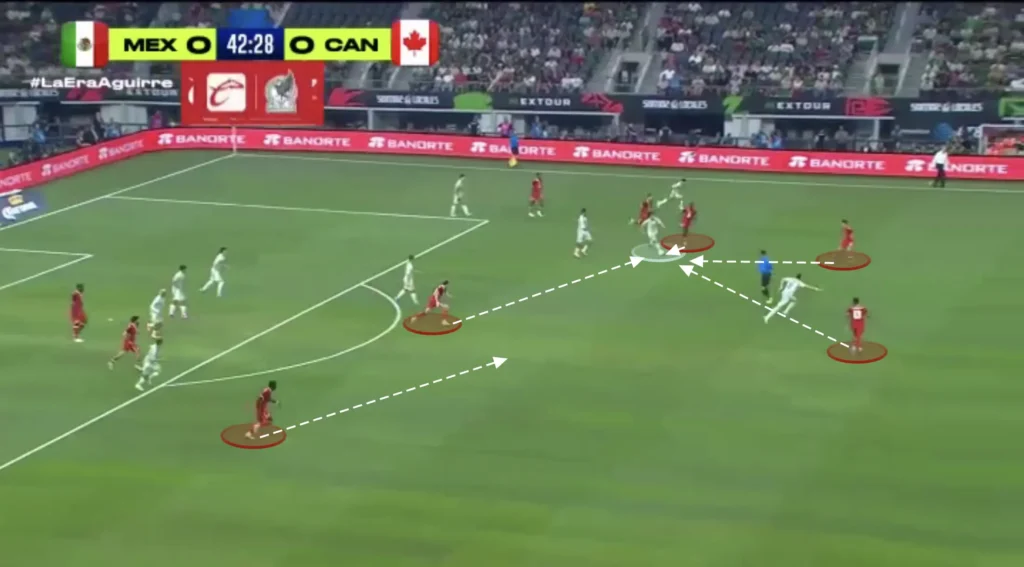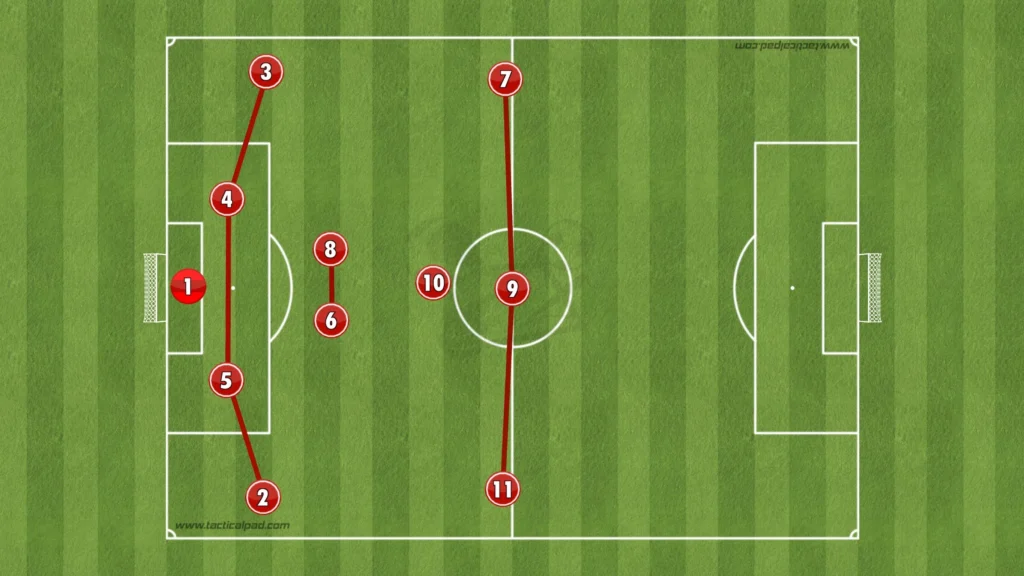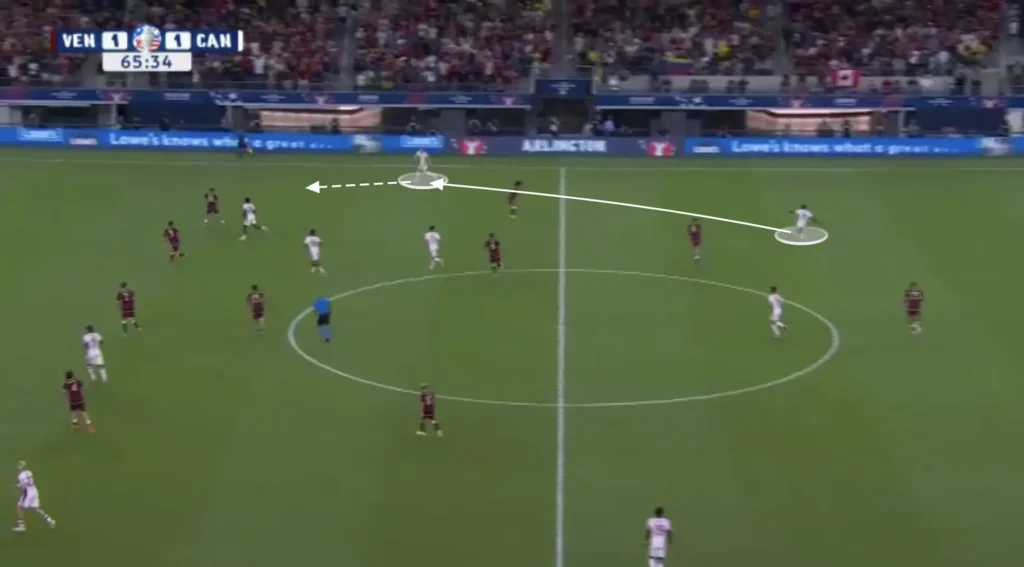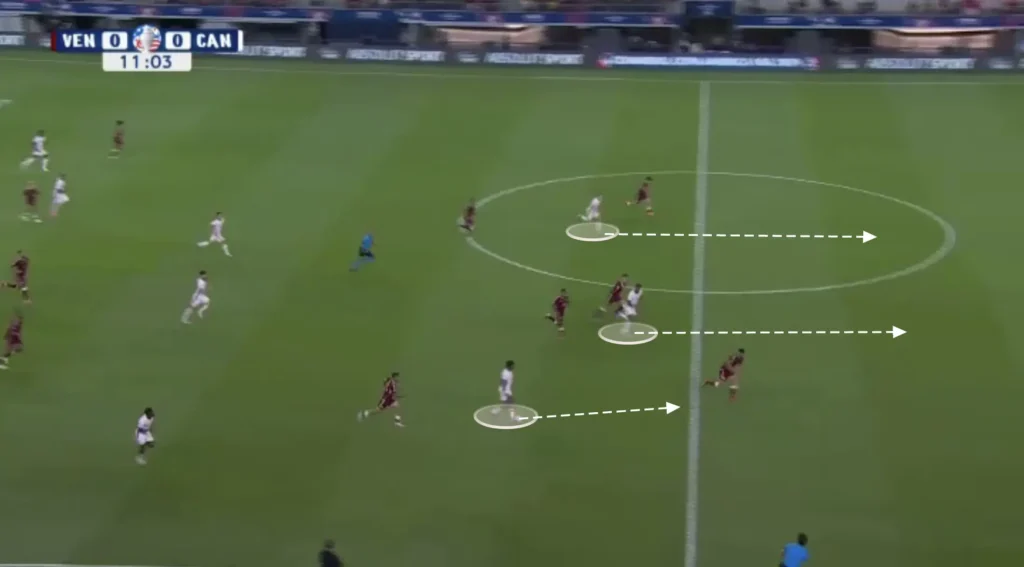Jesse Marsch brings an exciting tactical vision to the Canadian national team, blending high-intensity pressing with dynamic attacking play. His approach emphasizes energy, teamwork, and a bold style of football that aims to maximize Canada’s potential on the international stage. With a clear philosophy rooted in proactive strategies, Marsch looks to elevate the team’s performance and establish a distinctive identity. This analysis explores the tactical principles, formations, and key elements shaping Canada’s gameplay under Marsch’s leadership.
Defending
Canada’s base formation when defending is the 1-4-4-2 formation. They look to set up in a mid-block, always trying to close the center and force the opposition out wide.


Defending in the 1-4-4-2 formation is all about balance, compactness, and discipline. The team defends in two compact lines of four, with the forwards positioned ahead of the midfield. The two forwards play a crucial role, not only as the first line of defense but also in initiating the team’s pressing strategy. Marsch wants his team to stay compact without dropping too low, preferably closing the space between the midfield and backline.
High Backline (Def)
One tool that helps to be compact is to play with a high backline, making the space to the midfield line as small as possible. Marsch’s players do this and usually try to keep the highest line they can without leaving the space behind them too open. Defending with a high backline involves positioning the defensive line closer to the midfield rather than near the goalkeeper. This tactic compresses the space available for the opposing team to operate, disrupting their build-up play and increasing the chances of winning the ball back quickly.

A high backline also allows defenders to support the midfield more effectively, creating numerical superiority in central areas and facilitating quicker transitions from defense to attack. However, it requires defenders with good pace and positional awareness to deal with long balls and prevent opposing attackers from exploiting the space behind. This approach demands constant communication and coordination among the backline to maintain a cohesive and effective defensive structure.
Additionally, everyone must be in the same line when defending with a high backline to maintain an effective offside trap, ensure cohesive coverage, and reduce gaps that attackers can exploit. A well-aligned defensive line makes it easier to catch opposing forwards offside, preventing them from receiving the ball in dangerous positions.
Work Rate
Canada’s work rate when defending is exceptional, defined by relentless energy and discipline. Under Jesse Marsch, the team is organized and compact, with every player contributing to defensive duties. The midfield and forward lines press with intensity, closing down spaces and forcing opponents into uncomfortable positions. The Canada backline remains focused, consistently tracking runs and maintaining their shape. When a defender breaks out of shape to put pressure on an opposition player, a Canadian midfielder will always drop into the backline to cover for his teammate. This compactness ensures that the team stays solid defensively, making it harder for the opposition to break through with wide or central attacks.
Aggressiveness
Canada’s defensive strategy under Jesse Marsch is characterized by an aggressive approach both high up the pitch and lower down the pitch. The players apply immediate pressure even when retreating into a deeper defensive stance while maintaining a compact shape, closing passing lanes, and forcing opponents to play wide or make risky passes.
This aggressive approach enables Canada to squeeze the pitch when defending. This means constantly pushing the team up as much as possible. Every time the opponent plays a slow, sideways pass or a back pass, Canada’s first line of pressure pushes up, with the rest of the team following to stay compact. When the next pass comes, they push up even more, forcing the opponent back even more.

This approach keeps opponents under constant pressure, making it difficult for them to build rhythm or find space between the lines. It also pushes the opponent further away from the Canada goal, making it harder to create chances.
Counterpress
Canada under Jesse Marsch consistently applies aggressive counterpressing immediately after losing possession. This tactic focuses on regaining the ball quickly in advanced areas, disrupting the opponent’s transition before it begins. The team’s compact attacking structure ensures multiple players are close to the ball when possession is lost, enabling a coordinated press from multiple angles.


This strategy not only prevents the opponent from launching effective counterattacks but also creates opportunities for Canada to regain possession in dangerous positions. Marsch’s emphasis on intensity and positional awareness makes counterpressing a cornerstone of Canada’s defensive and offensive transition game.
High Press
Jesse Marsch also implements a high, ball-oriented pressing system designed to disrupt the opposition’s build-up and force turnovers in dangerous areas. Operating in a 1-4-4-2 formation, Canada begin with a compact and well-organized defensive shape, limiting central passing options for the opponent. This compactness ensures the team remains narrow and connected, ready to pounce when the ball is moved to the flanks.
When the opposition plays the ball wide, Canada’s press shifts into action. The ball-side winger and striker apply immediate pressure to the ball carrier, supported by the nearest central midfielder and fullback. This coordinated effort creates numerical superiority in wide areas, cutting off passing lanes and forcing rushed decisions. The far-side players stay compact and ready to anticipate switches of play or regain structure if the press is broken.

The winger will press from the inside, closing any passes into the middle. The ball-side striker will try to stop the opposition from switching sides by closing the pass to the ball-side center-back, while the Canada midfielders, who have shifted across, will push up on the opposition midfielders. This gives the opposition fullback very few passing options and often triggers a rushed long ball, which the Canada backline usually will win.

This aggressive pressing system not only helps Canada win the ball high up the pitch but also sets the tone for Marsch’s high-energy, front-foot football. By targeting the flanks, where teams are often more vulnerable under pressure, Canada maximizes its chances of regaining possession and quickly transitioning into attack.
Build-up
Canada’s build-up play under Jesse Marsch is marked by a highly fluid 1-4-2-1-3 structure, which offers flexibility and control in progressing the ball up the pitch.

In this setup, the back four provides a solid foundation, but the shape quickly adapts based on the positioning of the midfield and attacking lines. The two holding midfielders act as pivots, frequently dropping deep to create numerical advantages in the first phase, while the number-ten finds pockets of space between the lines to link up play. The wingers in the front three maintain width, stretching the opposition’s defense and creating lanes for forward passes, while the central striker stays ready to receive through balls or exploit space behind the defense. This fluidity not only helps Canada evade high presses but also enables them to maintain possession and initiate attacks in varied ways, making their build-up challenging to disrupt.
Canada have also used the 1-4-2-4 formation in the build-up, still keeping the same principles and fluidity.

Rotations and Fluidity
The Canadian players constantly rotate during the build-up. The team adopts a dynamic approach, shifting between formations to create numerical advantages and exploit spaces. Marsch’s focus is always to get the players into their best positions, where they can make the most out of their individual skills. He emphasizes versatility, with players interchanging positions seamlessly to maintain possession and disrupt the opposition’s defensive structure. This flexibility creates numerical superiorities in different areas, allowing Canada to bypass the opposition’s press while maintaining control.
Alphonso Davies will, for example, often push high up the pitch, taking on the role of a left-winger in Canada’s attacking setup. This allows the left-winger to invert, moving into central areas to support the midfield or create overloads.

This dynamic positioning helps Canada progress the ball more effectively and exploit space on the flanks. Davies’ pace and attacking instincts make him a constant threat, while the inverted winger adds tactical flexibility to their play.
When advancing the ball, Canada’s holding midfielders and defenders will often find the pushing Davies in the spaces outside the opposition defense with precise through-balls. From these positions, Davies will have enough time and space to take the ball forward and cross it into the attackers in the box.

Direct Build-up
Jesse Marsch’s Canada often take a direct approach in their build-up play, frequently opting for early long balls to target striker Cyle Larin. Rather than building through short passes, Canada’s strategy aims to bypass the midfield and immediately create pressure on the opposition’s backline. By sending early balls up to Larin, who is skilled in holding up play and winning aerial duels, they establish a platform from which Canada can quickly transition into attacking phases. This tactic not only leverages Larin’s physical presence but also keeps the opposition on alert, disrupting their defensive structure and allowing Canada’s supporting players to move into advanced positions where they can receive the ball.

When Canada beat the press, and a midfielder gets the ball in between the lines, the attackers will immediately make runs in behind, looking to exploit the space behind the opposition’s backline.

Building up like this offers minimal risk while allowing Canada to quickly advance the ball and keep the opposition under pressure. It also maximizes Larin’s strengths, enabling him to hold up play and involve his teammates higher up the field, creating fast-paced attacking opportunities.
Fullback Positioning
Something Jesse Marsch focuses on is the position of the fullback. When the center-backs have the ball, the ball-side fullback will usually be positioned slightly higher up than the opposition winger. He will be outside the winger, making sure the passing lane from the center-back is open. At the same time, he will be higher up than the winger, enabling him to take the ball past the winger when receiving a pass from the center-back. He can take his first touch forward with the back foot, progressing the ball past the opposition’s midfield line.

By doing this, Canada can beat both the opposition’s forward and midfield line with just one pass, enabling quick progression up the pitch.
Balls in Behind
The Canada attackers consistently make aggressive runs in behind the opposition defense when the fullbacks receive the ball. This movement is a key aspect of their offensive strategy, designed to stretch the defensive line and create space. As the fullbacks advance, the forwards will run in behind the opposition backline, exploiting gaps between defenders and allowing themselves to receive well-placed through-balls. The coordination between the fullbacks and attackers makes Canada’s offense unpredictable and difficult to defend against.


Additionally, this constant threat prevents the opposition from playing with a high backline and closing the space between the lines. Instead, they have to drop the backline and protect the space in behind. This opens the space in front of the backline for the Canadian midfielders to exploit.
Early Crosses
The through-balls from the fullbacks often turn into early crosses when the fullbacks receive the ball higher up the pitch. This is a key offensive weapon in Marsch’s attacking philosophy, capitalizing on the wingers’ speed and the aerial presence of their forwards. By delivering the ball into the box before the opposition’s defense is fully set, they create quick and unexpected scoring opportunities. The early cross approach allows Canada to bypass congested midfields and exploit any gaps left by defenders still recovering their positions.


High Backline (Off)
When Canada establish possession higher up the pitch, they focus on having the defenders high up and close to the center. This helps in the counterpress because they get closer to the midfield. Having more players close to the center who can win the ball back makes it difficult for the opposition to do anything when they win possession. Furthermore, the high backline shortens the distance between players, shortening the time and length of the passes and preventing the opposition from pushing up their defense.

Attacking the Half-Space
In the final third, Marsch’s players usually look to create chances by attacking the space between the opposition center-back and fullback. They primarily do this from the wide areas with underlaps from the midfielders. When the Canada winger receives the ball out wide, he will attract the opposition fullback. This opens the space between the opposition fullback and center-back, which allows a Canada midfielder to make the underlapping run into this space. The ball can be played to the underlapping player, who can cross the ball into the box or attack his defender in a 1v1 situation.


Additionally, the winger does not have to play the ball to the underlapping player. The run from the Canada midfielder will often drag away an opposition defensive midfielder, which opens the space inside. The winger can take the ball inside and shoot or find a pass to a free player in front of the backline.


Canada will also exploit this gap between the opposition fullback and center-back with through-balls to well-timed runs from the midfielders. These incisive movements add an extra layer to Canada’s offense, making it harder for defenses to stay organized.

Counterattacks
Canada’s counterattacks are a key element of their tactical approach under Jesse Marsch. The team is highly organized defensively, setting up with a compact, disciplined shape that allows them to quickly transition from defense to attack. Once they win the ball back, the Canada players waste no time moving it forward with precision and urgency.


Midfielders play quick, vertical passes to exploit the spaces left by an advancing opposition, often aiming for wide players or strikers who position themselves to break into the attacking third. The Canada players understand when to push forward aggressively and when to hold back, making them highly effective at creating scoring chances out of transitional moments.
Additionally, the Canada players are great at finding open spaces in the counterattacks. Instead of playing the ball straight forward where opposition defenders may still be positioned, they play a diagonal or sideways pass, allowing the team to bypass pressure and shift the play into open areas.

From these areas, the Canada attackers can take the ball forward and quickly get past the opposition to create a goalscoring opportunity.
Final Thoughts
In conclusion, Jesse Marsch’s potential impact on the Canadian national team could usher in an exciting new era of dynamic, high-intensity football. Known for his aggressive pressing system, vertical play, and ability to maximize player potential, Marsch’s philosophy aligns with Canada’s emerging talent pool. His tactical understanding and motivational leadership could provide the structure and belief needed to elevate the team’s performances on the international stage.
With Canada poised to build on its recent successes, Marsch’s appointment could represent a pivotal moment in shaping the nation’s footballing identity. If implemented effectively, his system has the potential to make Canada not just competitive but a formidable presence in the global game.
